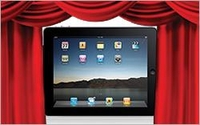
A curious debate has broken out online this week over using SMS and other device data functions in movie theaters. The effort to keep people off their phones during movies has become
such a fixture in theaters (often sponsored by the operators themselves) that it is jarring to see the case made for actual second-screen activity while watching a movie with strangers.
Hunter Walk is unapologetic and full-throated in making the case. He says he
has been going to the theater less and less in part because he now prefers a multitasked media experience that allows him to complement the main screen with celebrity look-ups, comments, back story,
etc.
Recalling for me the days of smoking sections (I am not only old enough to have remembered these, but old enough to have used them), he says theaters should embrace the opportunity.
“Instead of driving people like me away from the theater, why not just segregate us into environments which meet our needs. I’d love to watch Pacific Rim in a theater with a bit more
light, Wifi, electricity outlets and a second screen experience. Don’t tell me I’d miss major plot points while scrolling on my iPad -- it’s a movie about robots vs monsters. I can
follow along just fine.”
I like his spirit and the fact that he helped spark a real debate over this. He got a torrent of angry replies, accusing him of all manner of Satanic intent. It
even got a rise out of Elijah Wood, who called it ludicrous. Anil Dash defended Walk and targeted the sanctimony of his attackers with eccentric rhetoric. So of
course it became a Twitter war.
But it is a reasonable question. A no-talk zone falls within the widely accepted parameters
of civility in a public performance. Arguably, having second screens live in people’s laps in a theater would be an equally rude intrusion with ambient light. But having a separate section of
device users merely tapping glass screens surely can be a bother only to the unreasonable purist who can’t stand the idea of someone not enjoying a film the way they think he should.
One
commenter noted that separate screenings for families with children are already being done. Why not test one for second-screeners? In fact, spin that off into second-screen showings that movie makers
could themselves program. Imagine AR enhancements to the screen, in-theater voting on alternate scenes (which has been done by other means). The research I cited yesterday in Mobile Insider argues there are multiple types of audiences for media with
varying degrees and kinds of propensity for second-screen involvement. I am sure this is true of target audiences for different kinds of films. Walk was arguing originally that a "Transformers" film
really does not expect or merit the reverent focus of many other films with richer experiences. Add to that the fact that the audience for that film is probably more likely to want to engage in more
interactivity.
By the way, I say this as a movie purist myself who drives my wife crazy by needing to sit at the optimal center of a digital theater to get as clean a view as possible. Screen
seams drive me nuts, and my general attitude is that talkers should be muzzled, and loud eaters should have their jaws wired shut. I believe a quiet, dark, visually and aurally immersive film
experience is a right of filmgoers, and no test of theatrical second-screening should diminish that.
A section of iPad users? I think I could live with that. A filmmaker daring enough to
craft the first flick made to be second-screened in theaters? Don’t cut in line, buddy. I was here to get my ticket first. Beats the hell out of having 3D crammed down our throats for the last
three years.